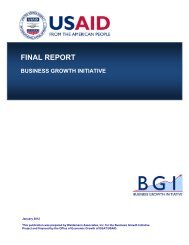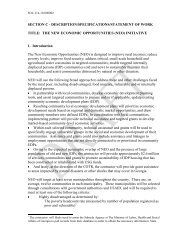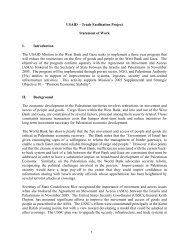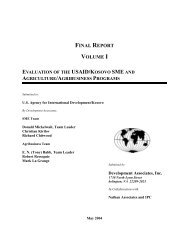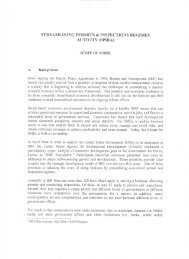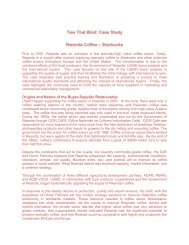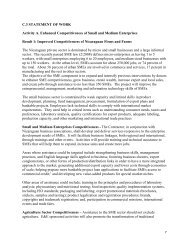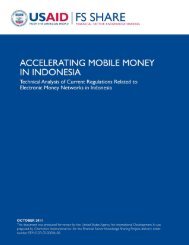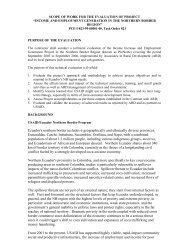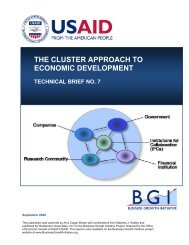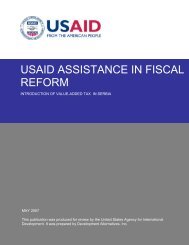Property Tax Reform in Developing and Transition Countries
Property Tax Reform in Developing and Transition Countries
Property Tax Reform in Developing and Transition Countries
You also want an ePaper? Increase the reach of your titles
YUMPU automatically turns print PDFs into web optimized ePapers that Google loves.
Annex B<br />
Successful <strong>Property</strong> <strong>Tax</strong> <strong>Reform</strong> <strong>in</strong> Bangalore City, India<br />
The property tax <strong>in</strong> Bangalore, the capital of the Indian State of Karnataka, has undergone a significant<br />
transformation over the past decade. Most notably, a sweep<strong>in</strong>g reform <strong>in</strong> tax structure has led to a<br />
significant <strong>in</strong>crease <strong>in</strong> revenues <strong>and</strong> <strong>in</strong> the rate of compliance (Rao, 2008). The most recent evidence<br />
suggests that the progress with revenue enhancement can be susta<strong>in</strong>ed. In this annex, we track the<br />
property tax through the various stages of its development <strong>in</strong> Bangalore.<br />
Phase I: 1957-2001<br />
The state government of Karnataka has long imposed a property tax on rental value. The state switched<br />
from an annual to a capital value basis of property taxation <strong>in</strong> 2002. The new tax base is the sum of l<strong>and</strong><br />
value as estimated from reported data on property transfers, <strong>and</strong> build<strong>in</strong>g values as estimated us<strong>in</strong>g a<br />
construction cost method adjusted for depreciation. In practice, the property tax saw little revenue growth<br />
dur<strong>in</strong>g the 1957-2001 period. A World Bank Report (2004, p. 2) described the situation as follows:<br />
“Perhaps the major explanation of the poor revenue performance is the failure to reassess properties for<br />
nearly 30 years. Another longst<strong>and</strong><strong>in</strong>g problem has been enforcement (a 55 percent collection rate).<br />
F<strong>in</strong>ally, the total enumeration of properties has lagged, <strong>and</strong> particularly new properties developed on the<br />
urban fr<strong>in</strong>ge have not been brought on to the property tax roll.”<br />
Phase II: Area Based Assessment 24<br />
In 2001, Bangalore moved to a new approach to assessment—an area-based unit value system—<strong>and</strong><br />
<strong>in</strong>troduced a new valuation roll. 25 At once these reforms got around the badly outdated list of values, with<br />
quite successful results.<br />
For assessment purposes, the metropolitan area was divided <strong>in</strong>to six l<strong>and</strong> value zones, with each “zone”<br />
assigned a rental value per square foot. A “zone” is not necessarily a contiguous area. Though build<strong>in</strong>gs<br />
are assessed accord<strong>in</strong>g to their capital values, these amounts are “factored” to rental value equivalents<br />
us<strong>in</strong>g a formula approach. The sum of the l<strong>and</strong> <strong>and</strong> the build<strong>in</strong>g value is the taxable rental value.<br />
Preferential treatment is granted to owner-occupiers <strong>in</strong> the form of a 50 percent reduction <strong>in</strong> value for<br />
certa<strong>in</strong> types of properties.<br />
When design<strong>in</strong>g the assessment rates, the city government limited the overall <strong>in</strong>crease <strong>in</strong> tax liability that<br />
a residential taxpayer would face to a multiple of 2.5. While a 250 percent <strong>in</strong>crease may seem very high,<br />
it should be noted that taxpayers’ liabilities were very low to beg<strong>in</strong> with.<br />
The so-called “self-assessment” feature of the Bangalore reform is that each taxpayer who chooses to<br />
voluntarily self-assess her tax is charged with identify<strong>in</strong>g the location of her property, <strong>and</strong> declar<strong>in</strong>g the<br />
classification of the structure. Based on the schedule of values provided by the tax<strong>in</strong>g authority, the<br />
taxpayer may then calculate her tax liability. The guidance values that were the basis of these assigned<br />
rates were drawn from declarations of sales values at transfer. The tax rate was set at 20 percent for<br />
24 In this section, we draw from World Bank, 2004.<br />
25 A number of large Indian cities have adopted an area-based system, <strong>in</strong>clud<strong>in</strong>g Ahmedabad, Bhopal, Patna,<br />
Luckknow, Mirzapur, Thrivananthapuram, Bangalore <strong>and</strong> Hyderabad. (Rav<strong>in</strong>dra <strong>and</strong> Rao, 2002).<br />
33



